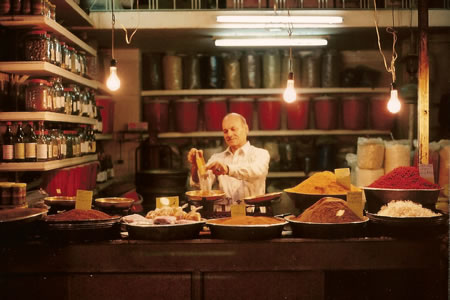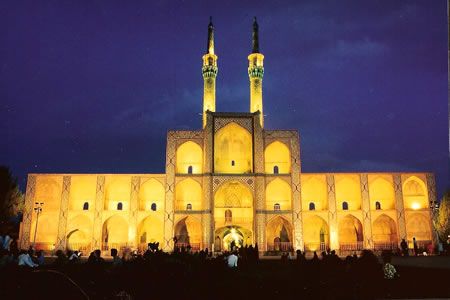

| Iran and its legendary hospitality | |
Teheran (Iran), August 5th 1998 |
|
When you talk about Iran, western people normally think of its troublesome relationship with the west and the dreadful war between Iraq and Iran. Not strange, if one only sees Iranian man on television when they are burning flags or destroying western symbols. The enormous hospitality of the common people, its fascinating history and the remains thereof are often forgotten. In 1998 we decided we wanted to see Iran ourselves. We wanted to feel the atmosphere of the stories of thousand and one nights, and wanted to meet the Iranian people and see for ourselves how they react on us.
After checking out what to wear (see also To set for Iran), we went to Iran on the fifth of July 1998. Quickly we found our way in Teheran, and on one of the first days we visited the mausoleum of ayatollah Khomeini. A beautiful site with a serene atmosphere. After a while we met a scholar of 16 years old who liked to show us around at the mausoleum. He spoke English very well, and liked to practice it to speak it even better. He learned the language by hearing international radio broadcasting. After having a delicious ZamZam (local cola) together, we went to the graveyard of the military forces that hadn’t survived the Iran-Iraq war. Everyone knows the horrors that have taken place during those years, but the immense size of this graveyard with also very young victims makes you even more conscious of this. On top of the graves of each victim, a small display case is installed with personal belongings and pictures. This gives the immense amount of victims a face. With Iranian flags waving everywhere, I am sure that everyone who visits the graveyard will be impressed. Our friend explained us that his government helps the families of martyrs by giving the children a higher chance to study at the university. As his father luckily survived the war, he could get his university degree, but not the study of his first choice. However, he seemed happy to give up his rights for the ones who suffered more for his country. At the end of the day we promised to call him when we came back to Teheran, to meet him again. |
|
 |
|
Cemetery in Teheran for the victims of the war with Iraq |
|
| After a few days in Teheran we went to Esfahan. A great city, with the most beautiful mosques, nice open spaces on the river shore to relax and beautiful teahouses. The teahouses are a great way to meet new people. We met a father and his daughter who were waiting to go to the university. The daughter was a little nervous because she had to do an entrance exam in a few hours, and she seemed happy that she had a little distraction by talking to us. Frankly, they talked about the way the felt about the western people. As most Iranians we would meet during our trip, they made a clear distinction between western civilians and the western governments. They love to meet the western civilians, but they feel misunderstood and mistreated by the western governments. During the times of the Shah, the West seemed to love Iran. The Shah was a close ally of the US, but he wasn’t that beloved by the Iranian people. For instance: in public area’s, a headscarf wasn’t acceptable while the main part of the population didn’t agree with that. After the Islamic revolution, friendship between Iran and the US ended quickly. The hostility of the US versus Iran became very clear in the Iran-Iraq war, as the US acted as main supplier of weapons to Iraq. With lots of men killed in the war, Iranians have difficulty to forgive the interference of the US-government. Despite that, they love to meet western travellers who are seriously interested in their country. They know that western travellers don’t have to think the same as the government of their country. Hence, they also have different opinions as their own government but they aren’t always in the position to speak out loud.
After visiting the obvious and very beautiful highlights in the southern part of Iran (e.g. Shiraz, Yazd, Persepolis, Bam) we went back to Teheran to where we met our 16-year-old friend. He knew that we were leaving the next day to the holy city of Mashhad, but he invited us to stay a few days at his parents’ house at the end of our journey. |
|
 |
|
Shop for spices in Esfahan |
|
| For Shiites, Mashhad is extremely sacred because this is the place that the eighth grandson of Prophet Mohammed died in 817. His tomb has become a major pilgrimage site, so it isn’t strange that most Iranians hope to visit Mashhad at least once in their lifetime. Visitors who are modestly clothed are able to visit most parts of the holy shrines, and people are happy to show you around. Mashhad will never fail to impress a visitor.
After enjoying the busyness of Mashhad we visited several less visited attractions as the city of Hamadan. Just 40 years ago, a local shepherd discovered the Alī Sadr Caves (100 km north of Hamadan) when looking for a goat that ran away. We went there on a Friday because we were told that it would be pleasantly busy at a Friday, and it was. So, if you like to be alone in a cave….don’t go on a Friday! Lots of schoolchildren where there on their school outing, and large families were squeezing themselves into the small rowing boats. Those boats are tied up to each other, and attached to the paddleboat that a guide is steering. The atmosphere was full of joy, and after a boat tour of half an hour, we could walk through the walkways in the middle of the cave. Every step we took, we were stopped by a horde of children asking where we came from, if they could make a picture of us etcetera. Unfortunately, our Farsi is limited to the standard words (e.g. Thank you, Goodmorning). However, those few words were enough to get in contact with the loveliest people. After a short while, a friendly looking middle-aged man came to us and asked us in English whether we would like to have lunch with his family. Soon we became to know that his family was not just he, his wife and his children. In Iran, the family is the extended family with the grandparents, uncles, aunts, and their children. After getting out of the caves, we went to a shelter to get out of the burning sun. A gas burner was lit, and then it was teatime. Afterwards the women baked great kebabs. Girls were helping cutting the salads and everyone had a great time chatting with each other while the boys were playing soccer. Soon we became to know that the English speaking man was an English teacher in a small village a few hundred kilometres from Hamadan. They had never met foreigners before, and invited us for a visit to their village. We could stay at their place, and they would show us around. Overwhelmed by their hospitality, we told them that all our belongings were at the hotel so we would have to pick that up first. They were disappointed that we could not come with them, so we stayed until late in the afternoon having great fun in front of the caves. After exchanging addresses, we promised to call them soon to tell them if we were able to come down to their village. After buying presents for our hosts, we went a few days later to this village. |
|
 |
|
Amir Chakmagh complex in Yazd |
|
| This will be something that we will never forget. After arriving, Edwin was driven through the village on a moped, while Ivonne was able to learn how the traditional Iranian food is prepared. We met so many people, inviting us into their houses. We ate an immense amount of delicious food, drank litres of sweet tea. People played traditional music instruments for us; together we went to the beautiful surrounding mountains. We danced, we laughed, we talked about our religions, and we learned from each other how we live in daily life. In short, we had the most amazing time with these great people. Sometimes you read that lots of Iranian families are very western as soon as they are at home (e.g. lots of make up). These people were more traditional, and they also told me that they invited us because we were dressed modestly. As a woman, I was also able to get in close contact with the women and we had a great time. They taught me a few words of Farsi, while I taught them English. At night, when I would take my scarf off when I would go to sleep they asked I they could get into my room. They wanted to see my hair; they wanted to touch my skin.
After a few days we had to go back to Teheran because a few days later our plane would leave. It’s strange how close you can get in a few days. When leaving for the bus, we had to walk under the Koran that they held up, and the woman were throwing bowls of water behind us for good luck. When arriving in Teheran, more amazing days were to come. Our sixteen-year-old friend took us to his family home. The great days that followed were once again filled with great people. For us Dutch it is amazing that a son of 16 is inviting two complete strangers to stay for a few days in his parents’ house. We weren’t even in need! It was just because they just liked to get in touch with us as much as we loved to get in touch with them. As we met the parents, the brothers and the sister and the extended family we knew that amazing days at the small village would proceed in the big city Teheran. Those days were indeed great, and not just because they took us to the “unknown” great spots around the city. Once again, it will be the people that we never forget. Unfortunately, the day of saying goodbye came. The rituals with the Koran and the bowls of water took place and afterwards, we went to the airport. When leaving Iran, we knew one thing for sure. We will meet our friends again, and we will certainly come back to this great country. © copyright - Babakoto.eu / 2006 |
|